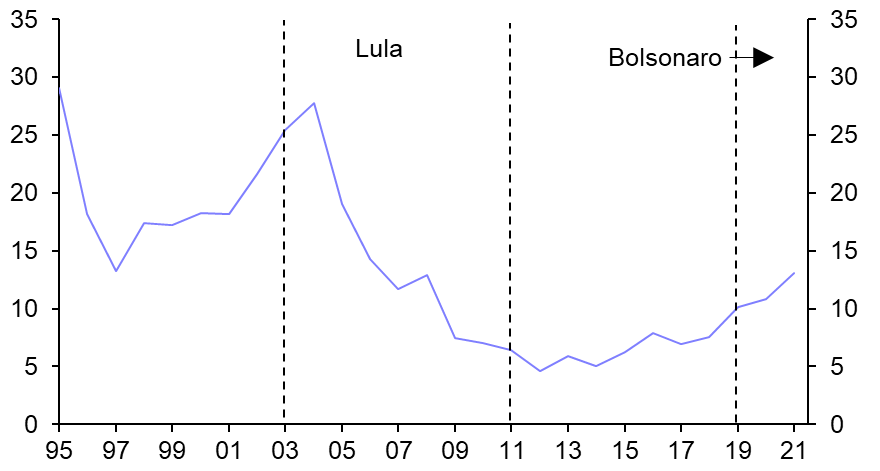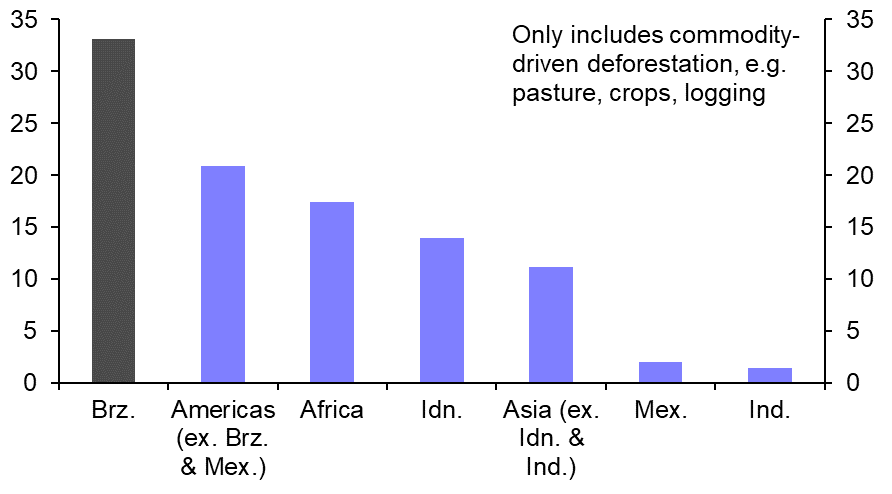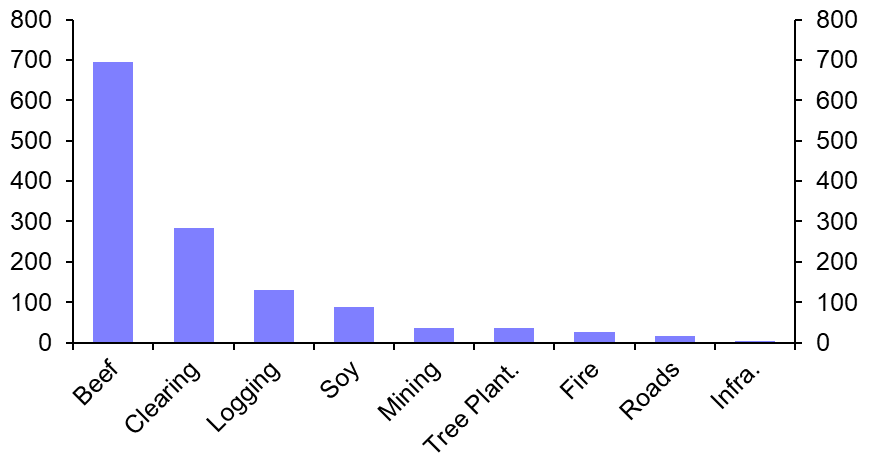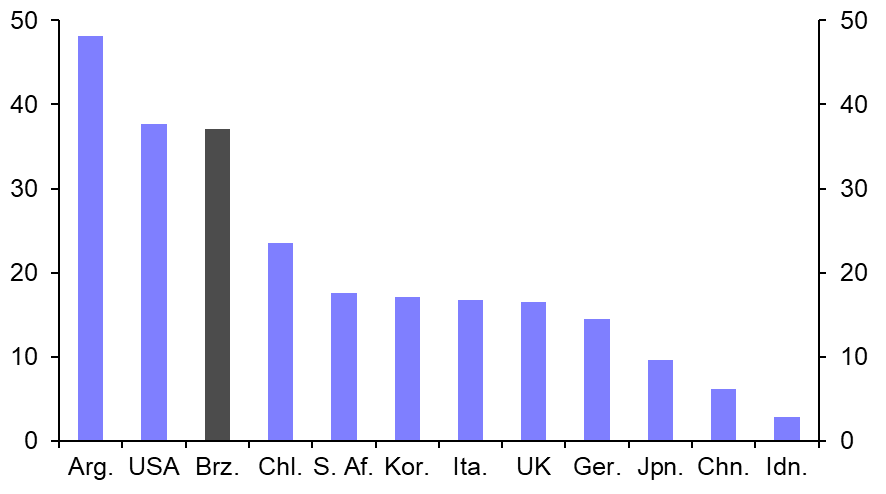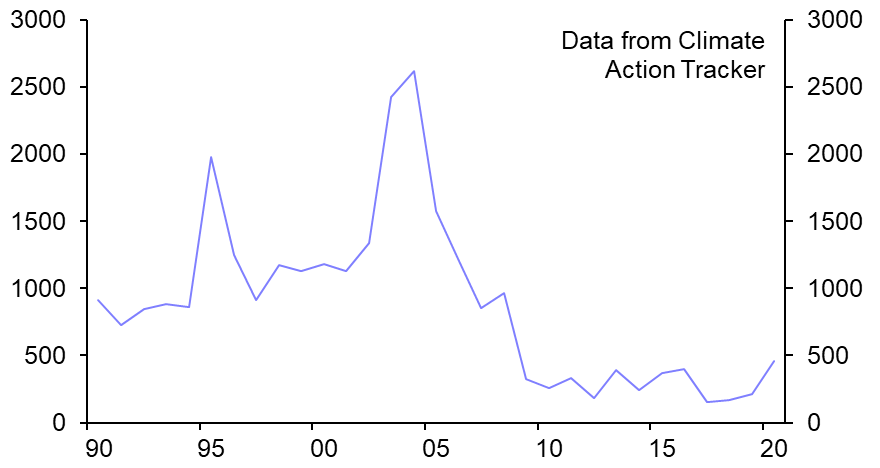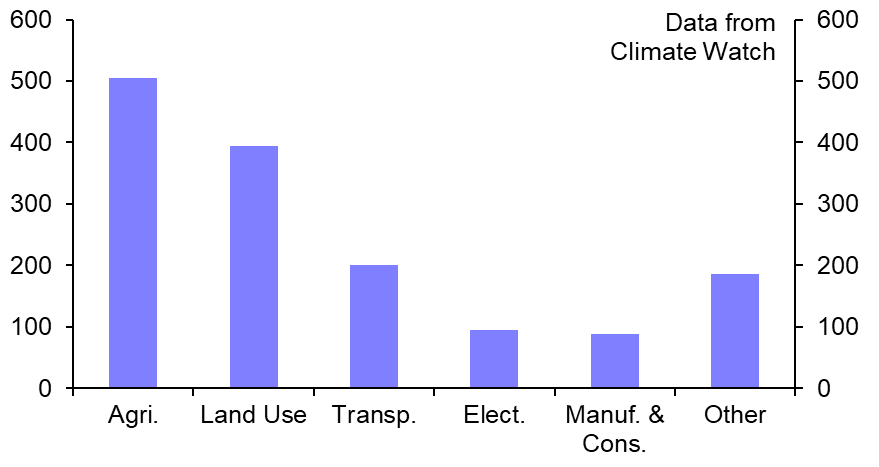- Environmental policy is one channel through which Brazil’s presidential election has global implications. The country is the single largest source of deforestation in the world and, with deforestation often leading to cattle ranching, Brazil plays an outsized role in global greenhouse emissions. The front-runner Lula has made environmentalism a key part of his platform and, if he has the success in combatting deforestation that he had in the 2000s, that might weigh on Brazil’s agricultural sector but could also lead to improved foreign relations and, possibly, support investor sentiment towards the country too.
- Brazil’s presidential race culminates on 30th October in a vote pitting incumbent Jair Bolsonaro against former president Lula, with Lula seemingly the favourite to win. (See here.)
- Lula had a strong track record on reducing deforestation when president from 2003 to 2010. Data from Brazil’s National Institute for Space Research (INPE) show that deforestation in the Amazon fell by over 70% during his previous presidency. (See Chart 1.) This was achieved by increasing protected areas, better monitoring, stronger enforcement, larger penalties for deforestation and tying subsidised rural credit to compliance with environmental regulations. That dramatic decline in deforestation was all the more stark given that it coincided with soaring agricultural prices, which would have incentivised deforestation.
- Bolsonaro’s administration did sign up to the Declaration on Forests and Land Use at COP26 last year. And his manifesto talks of strengthening environmental policy (combatting deforestation, promoting green technology, etc.). But it is balanced against the need for economic development. He is generally more reliant on support from agricultural interests. And deforestation has risen in his first term.
- Brazil is the single largest contributor to deforestation globally. (See Chart 2.) Most deforestation occurs in the Amazon, although it also occurs in other biomes, most notably the Cerrado, a tropical savannah that spreads through much of the centre of the country. The majority of deforestation in the Amazon is driven by demand for land for cattle production, with a smaller amount for soybeans and logging. (See Chart 3.) Around 80% of Brazilian beef production is for the domestic market with the rest exported (in part reflecting beef’s important role in Brazilian food culture – see Chart 4). Academic studies suggest that beef for the domestic market is more likely to be from newly-deforested areas compared with exported beef.
- Unsurprisingly, deforestation in Brazil also makes a significant contribution to global greenhouse (GHG) emissions. When forests are cleared or burnt, they release stored carbon dioxide into the atmosphere, and their ability to absorb CO2 in the future is diminished.
- There are a few important caveats when looking at deforestation’s contribution to GHG emissions. For one thing, it is generally recorded under a broader category, “land use”, which also includes things like crop burning and rice cultivation (although in Brazil’s case, land use is mainly deforestation). Another caveat is that estimates of GHG emissions from land use are subject to more uncertainty than in other categories (e.g. it has to be measured via satellite monitoring, carbon stored in forests needs to be estimated).
- But even with this note of caution in mind, most estimates of land use GHG emissions in Brazil coalesce around a similar level. Perhaps the best time series of land use emissions in Brazil comes from Climate Action Tracker. These data suggest that emissions have fallen dramatically since the early 2000s, hand in hand with the decline in deforestation. (See Chart 5.) But even so, Brazil is the third largest GHG emitter globally in the land use category (only Indonesia and the Democratic Republic of Congo are higher). And Brazil’s land use emissions account for about 0.8% of all global GHG emissions.
- The fact that deforestation is used for beef production then further increases Brazil’s GHG emissions. The agricultural sector is now the largest single contributor to Brazil’s overall GHG emissions (around 35% – see Chart 6) and accounts for around 1.0% of total GHG emissions. Most emissions from Brazil’s agricultural sector are of methane (mainly from cattle’s enteric fermentation, better known as burping), followed by nitrous oxide (mainly from fertiliser use).
- Deforestation and cattle ranching explain why Brazil plays an outsized role in global GHG emissions. Brazil's GHG emissions account for around 3% of total GHG emissions (allowing for land use and forestry), compared with Brazil's share of just over 2% of global GDP and the global population. Were it not for these factors, Brazil would actually have relatively low emissions given its size (mainly reflecting the country’s use of hydropower for electricity generation).
- In terms of what all this means for Brazil’s economy, if Lula wins and combatting deforestation is prioritised, there might be a near-term impact on agricultural output (which, all else equal, would be lower). That said, agriculture is a relatively small part of Brazil’s economy (at around 5% of GDP) and the effects on GDP are likely to be swamped by other factors. After all, the decline in deforestation in the 2000s coincided with a stellar period of economic growth for Brazil.
- And there would be positive knock-on effects. Efforts to combat deforestation would probably lead to improved global perceptions and foreign relations. A survey by GlobeScan in 31 countries last year found that deforestation in the Amazon was considered as serious a problem as unemployment and access to healthcare. Meanwhile, foreign investor sentiment towards Brazil may improve – or, at least, measures to protect the Amazon might offset some concerns about Lula’s economic policies.
- Finally, such policies would reduce the risk that other countries eventually take retaliatory action for a perceived lack of control of deforestation. It’s worth noting that the long-awaited EU-Mercosur trade deal has yet to be ratified until Brazil makes a political commitment to curbing deforestation in the Amazon.
|
Chart 1: Deforestation in the Amazon (Thsd. km2) |
Chart 2: Share of Tropical Deforestation (% of Total) |
|
|
|
|
Chart 3: Drivers of Deforestation in |
Chart 4: Beef Consumption Per Capita (kg, 2019) |
|
|
|
|
Chart 5: Brazil GHG Emissions from |
Chart 6: Brazil GHG Emissions by Industry |
|
|
|
|
|
Sources: IBGE, OWID, FAO, Climate Action Tracker, Climate Watch, INPE, CE |
William Jackson, Chief Emerging Markets Economist, william.jackson@capitaleconomics.com
